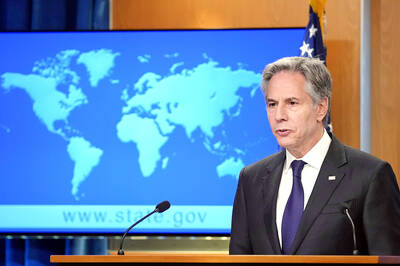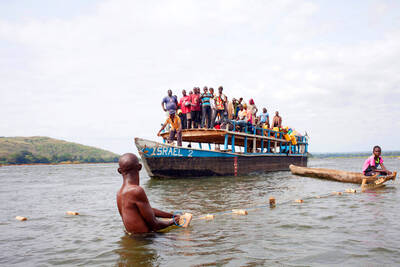Nature has shown solutions to problems this year, inspiring scientific discovery in a host of unexpected ways.
Nature is “a source of inspiration for science, because it has figured out the way Earth supports life,” Lex Amore from the Biomimicry Institute said.
“It is imperative we look to the biological blueprints that have been successful over millennia to launch groundbreaking ideas faster,” she said.

Photo: AFP
From forests to the depths of the oceans, there is “so much intelligence” to tap into in the natural world, Amore said.
“We can use biomimicry, this practice of studying nature and replicating its strategies in design, to not only learn from nature’s wisdom, but also heal ourselves — and this planet — in the process,” she said.
From smelly durians that could charge electric vehicles to sea sponges that might help build better spaceships, here is a selection of this year’s scientific work inspired by nature:
PARASITIC WASPS
Removing tumors and blood clots through minimal invasive surgery might soon become easier thanks to a flexible, ultra-thin and steerable needle inspired by parasitic wasps.
These formidable insects inject their eggs into living hosts such as caterpillars through a hollow needle called the ovipositor.
Scientists from the Delft University of Technology in the Netherlands studied the ovipositor’s delivery mechanism, with blades that slide up and down alternately, using friction to push the eggs through.
Researchers designed a needle made up of sliding rods that imitate the ovipositor, according to a recent study in Frontiers in Bioengineering and Biotechnology.
They say that the new needle is capable of reaching deeply buried parts of the body to inject medicine or remove harmful formations, while minimizing trauma and patient recovery time.
This is a starkly different outcome than for the targets of parasitic wasps, whose larva often devour their caterpillar host from the inside.
SPIDER SILK
Spiders make silk to entangle unsuspecting bugs, but now humans can use it to make optical lenses capable of picturing viruses that are invisible to the naked eye.
In a June study published in the Journal of Applied Physics, scientists said that they used daddy-long-legs’ dragline silk — which makes a web’s frame — as a support for the lens.
In experiments, they covered a strand of spider silk in wax then dripped resin onto it. As it condensed, the silk naturally formed a dome, which researchers baked in an ultraviolet oven.
The resulting optical lens is about the size of a red blood cell, and could be used to picture nano-scale objects such as viruses or the insides of biological tissue.
As the lens is made from natural, non-toxic material, it can safely be used inside the body.
SEA SPONGE
An intricately latticed marine sponge called the Venus’ flower basket found in the depths of the Pacific Ocean could inspire stronger skyscrapers, longer bridges and lighter spacecraft, according to a September study published in Nature Materials.
Scientists discovered that the structure of the sponge’s tubular skeleton gives it a higher strength-to-weight ratio than traditional designs that have been used for centuries for buildings and bridges.
“We’ve been studying structure-function relationships in sponge skeletal systems for more than 20 years and these species continue to surprise us,” said coauthor James Weaver, a Harvard University scientist.
STINKY FRUIT
To some they are succulent and delicious, to others they are so overpoweringly stinky that they are routinely banned from hotel rooms across Southeast Asia.
However, the durian might be about to add a new reason for its fame — helping to charge mobile phones and electric vehicles.
In a February study published in the Journal of Energy Storage, scientists described how they made extremely light and porous materials called aerogels from the fruit.
Aerogels are “great super-capacitors,” which resemble energy reservoirs that dole out energy smoothly, coauthor and Sydney University associate professor Vincent Gomes said.
Super-capacitors “can quickly store large amounts of energy within a small battery-sized device,” he said.
BAMBOO BUILDINGS
Vehicles, planes and buildings are mostly made of steel, concrete or brick. Bamboo has attracted interest as a versatile construction material, but how can it be made strong enough?
In a May study published in the ACS Nano, researchers said they had found an answer.
By partially removing the lignin — an organic substance that forms woody tissue — and microwaving the bamboo, researchers said that its strength nearly doubled.
Bamboo is already used to build houses and bridges, but this new discovery might further increase its popularity as a light, fast-growing and sustainable alternative to other materials.

‘IN A DIFFERENT PLACE’: The envoy first visited Shanghai, where he attended a Chinese basketball playoff match, and is to meet top officials in Beijing tomorrow US Secretary of State Antony Blinken yesterday arrived in China on his second visit in a year as the US ramps up pressure on its rival over its support for Russia while also seeking to manage tensions with Beijing. The US diplomat tomorrow is to meet China’s top brass in Beijing, where he is also expected to plead for restraint as Taiwan inaugurates president-elect William Lai (賴清德), and to raise US concerns on Chinese trade practices. However, Blinken is also seeking to stabilize ties, with tensions between the world’s two largest economies easing since his previous visit in June last year. At the

UNSETTLING IMAGES: The scene took place in front of TV crews covering the Trump trial, with a CNN anchor calling it an ‘emotional and unbelievably disturbing moment’ A man who doused himself in an accelerant and set himself on fire outside the courthouse where former US president Donald Trump is on trial has died, police said yesterday. The New York City Police Department (NYPD) said the man was declared dead by staff at an area hospital. The man was in Collect Pond Park at about 1:30pm on Friday when he took out pamphlets espousing conspiracy theories, tossed them around, then doused himself in an accelerant and set himself on fire, officials and witnesses said. A large number of police officers were nearby when it happened. Some officers and bystanders rushed

Beijing is continuing to commit genocide and crimes against humanity against Uyghurs and other Muslim minorities in its western Xinjiang province, U.S. Secretary of State Antony Blinken said in a report published on Monday, ahead of his planned visit to China this week. The State Department’s annual human rights report, which documents abuses recorded all over the world during the previous calendar year, repeated language from previous years on the treatment of Muslims in Xinjiang, but the publication raises the issue ahead of delicate talks, including on the war in Ukraine and global trade, between the top U.S. diplomat and Chinese

RIVER TRAGEDY: Local fishers and residents helped rescue people after the vessel capsized, while motorbike taxis evacuated some of the injured At least 58 people going to a funeral died after their overloaded river boat capsized in the Central African Republic’s (CAR) capital, Bangui, the head of civil protection said on Saturday. “We were able to extract 58 lifeless bodies,” Thomas Djimasse told Radio Guira. “We don’t know the total number of people who are underwater. According to witnesses and videos on social media, the wooden boat was carrying more than 300 people — some standing and others perched on wooden structures — when it sank on the Mpoko River on Friday. The vessel was heading to the funeral of a village chief in